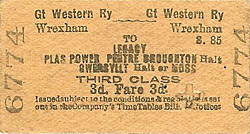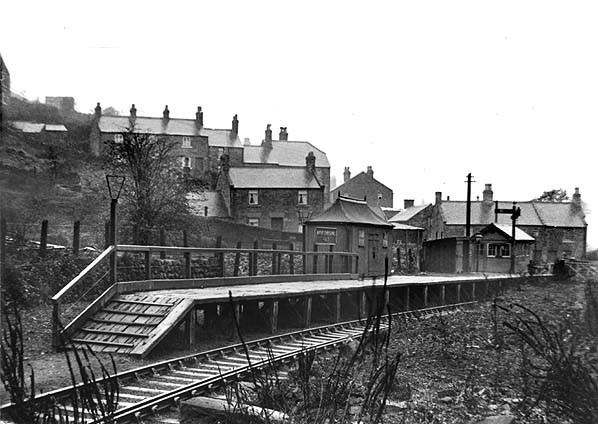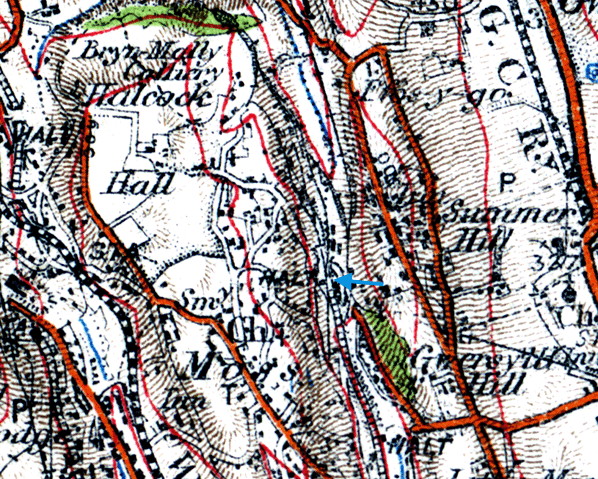Notes: Moss Halt (alternatively known as Moss Platform) was situated on the Great Western Railway (GWR) Moss Valley branch which ran from a junction with the Wrexham & Minera Railway at Moss Junction to Moss and onwards to Brynmally Colliery. The line opened as a single-track railway on 11 May 1882. At two miles in length it had been constructed so that locomotive-hauled trains could reach collieries and other industrial premises at the north end of the Moss Valley. A railway from Wheatsheaf Junction, on the Chester and Shrewsbury line, to Minera had opened in 1847 and it passed through Moss and so was able to serve the industries there. The 1847 line was a great success, but it was very steeply graded and had two rope-worked inclines which, as the nineteenth century progressed, impeded the smooth flow of traffic. The Moss Valley branch improved the situation greatly.
The line was built as a goods railway but on 1 May 1905 the GWR introduced a ‘railmotor’ service between Wrexham General and Moss. Halts were opened at Gatewen, Pentre Broughton, Gwersyllt Hill and at Moss.
Moss Halt was located to the south of the village at the bottom of Moss Hill and between Westminster and Moss Roads. It was the terminus for passenger services but the line continued northwards to Brynmally Colliery passing over a level crossing which was located to the north of the station.
 |
Moss had a single wooden platform on the west side of the line on which stood a corrugated iron waiting shelter, a small wooden shed and at the north end a signal box which controlled the level crossing. Directly to the east of the halt was the Westminster Colliery which had its first shafts sunk in the mid nineteenth century. It had extensive sidings which branched off |
from the Moss Valley line to the south of the halt.
There is some confusion regarding its name, being referred to in Bradshaw timetables at different times as Moss Halt and as Moss Platform. On the only known picture of the halt, taken around 1910, the nameboard has a third version of the name: Moss Crossing Halt. In Great Western Railway: a register of halts and platforms, the authoritative railway historian C R Clinker refers to it only as Moss Platform, whilst he acknowledges name variations for many other ‘halts’, and K Robinson in Great Western Halts (volume 2) notes that Moss was ‘officially designated by the GWR as a Platform’. Two criteria which set ‘Platforms’ apart from ‘Halts’ were that the former were staffed, generally by a senior grade porter (‘platform attendant’) and handled parcels traffic; Moss fulfilled both criteria.
The July 1922 Bradshaw showed ten weekday trains from Moss Halt for Wrexham General. On Saturdays there were thirteen departures to Wrexham. There was no Sunday service.
Bus competition had started to make inroads into passenger traffic receipts by the early 1920s. In February 1925 Westminster Colliery closed. By the early 1930s passenger services on the Wrexham and Moss line were hopelessly uneconomic, and the GWR withdrew the service completely with effect from 1 January 1931; Moss Halt closed completely on this date. By the 1930s the mines of the Moss Valley were worked out and, as a result, the Moss Valley line closed in 1935 when Brynmally Colliery closed. The track remained in situ until 1952. Being of timber construction all traces of the halt disappeared.
In the 1970s the Moss Valley was landscaped and the Moss Valley Park was created.
Ticket from Michael Stewart, Bradshaw from Nick Catford , route map drawn by Alan Young.
Sources:
- British Railway Companies, C. Awdry, 1990, Guild Publishing.
- Clinkers Register of Closed Passenger Stations and Goods Depots in England, Scotland and Wales - 1830 -1970 , C. R. Clinker & J. M. Firth, 1971
- Marcher Railways, by A. Bodlander, M. Hambly, H. Leadbetter, D. Southern & S. Weatherley, 2008, Bridge Books.
- Forgotten Railways - North and Mid Wales, Rex Christiansen, 1976, David & Charles.
- Railway Passenger Stations in Great Britain, M Quick, 2009, RCHS.
- Railway World - February 1987 - The Wrexham & Minera Joint Railway, Rex Christiansen, Ian Allan Publishing.
- Bradshaw Timetable July 1922.
To see other stations on the Moss Valley Line click on the station name: Gatewen Halt, Pentre Broughton Halt, & Gwersyllt Hill Halt
See also Wrexham and Minera Railway: Plas Power, The Lodge, Brymbo (GWR, Pentresaeson Halt, Coed Poeth, Vicarage Crossing Halt & Berwig Halt
|



.jpg)
platform.jpg)
.jpg)
.jpg)



.jpg)
.jpg)

 Home Page
Home Page